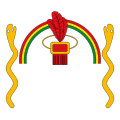Neo-Inca State
| Neo-Inca State | ||||||||||||
| Tawantinsuyu (Quechua) | ||||||||||||
| Independent state in Vilcabamba Vassal of the Spanish Empire (1567–1571) |
||||||||||||
|
||||||||||||
|
Modern Department of Cusco within Peru; the limits of the Neo-Inca State are unclear
|
||||||||||||
| Capital | Vilcabamba | |||||||||||
| Languages | Quechua | |||||||||||
| Religion | Inca religion, Roman Catholicism | |||||||||||
| Government | Monarchy | |||||||||||
| Sapa Inca | ||||||||||||
| • | 1537–1544 | Manco Inca Yupanqui | ||||||||||
| • | 1545–1560 | Sayri Túpac | ||||||||||
| • | 1563–1571 | Titu Cusi | ||||||||||
| • | 1571–1572 | Túpac Amaru | ||||||||||
| Historical era | Early modern | |||||||||||
| • | Manco Inca Yupanqui created the Neo-Inca state of Vilcabamba | 1537 | ||||||||||
| • | Treaty of Acobamba | 1566 | ||||||||||
| • | Spanish conquest led by Francisco de Toledo | 1572 | ||||||||||
|
||||||||||||
| Today part of |
|
|||||||||||
The Neo-Inca State, also known as the Neo-Inca state of Vilcabamba, was the Inca state established by Inca emperor Huayna Capac's son Manco Inca Yupanqui in Vilcabamba in 1537. It is considered the remnants of the Inca Empire (1438–1533) after the Spanish conquest. It lasted until 1572, when the last Inca stronghold was conquered, and the last ruler, Túpac Amaru, Manco's son, was captured and executed. This ended resistance to the Spanish conquest under the political authority of the Inca state.
During the Spanish conquest of the Inca Empire, Túpac Huallpa was a puppet ruler crowned by the conquistador Francisco Pizarro. After his death, Manco Inca Yupanqui joined Francisco Pizarro and Diego de Almagro in Cajamarca. When Pizarro's force arrived in Cusco, he had the caciques acknowledge Manco as their Inca. Manco Inca then joined Almagro and Hernando de Soto in pursuit of Quizquiz.
...
Wikipedia


